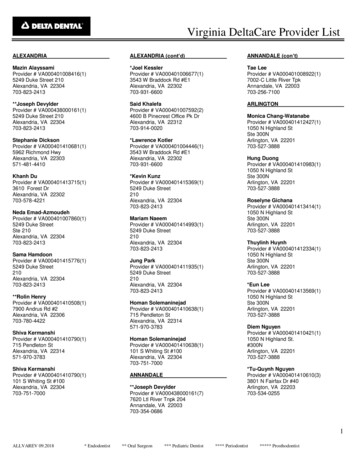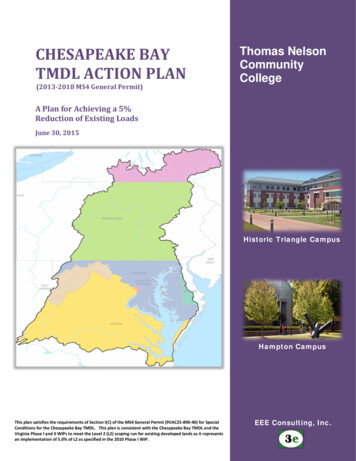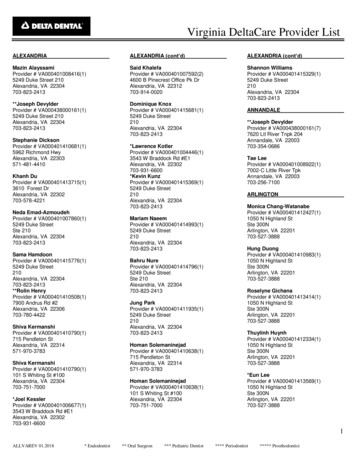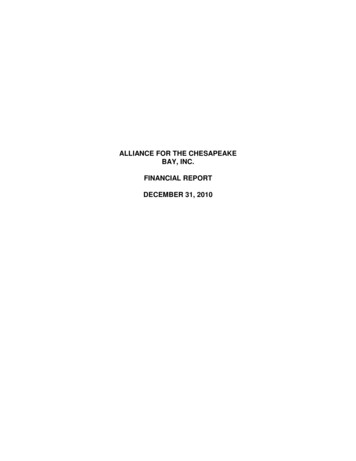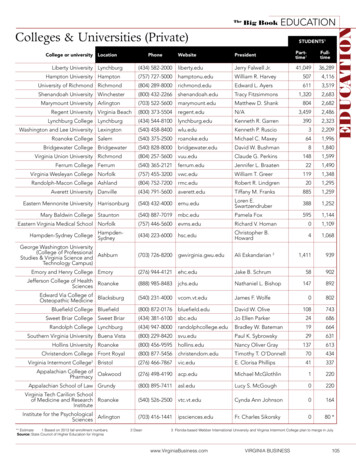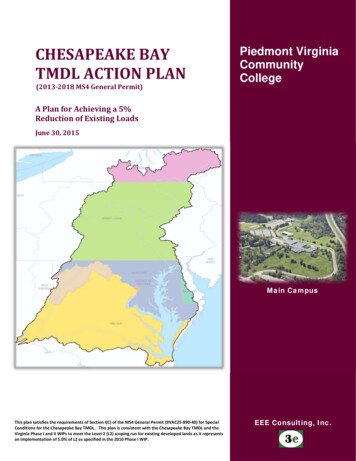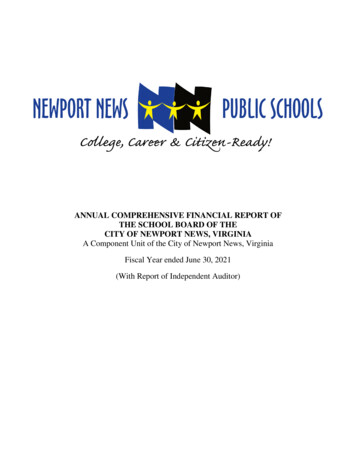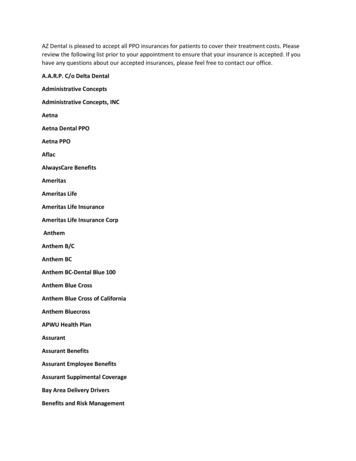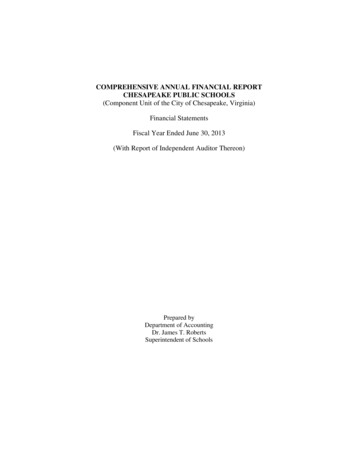
Transcription
COMPREHENSIVE ANNUAL FINANCIAL REPORTCHESAPEAKE PUBLIC SCHOOLS(Component Unit of the City of Chesapeake, Virginia)Financial StatementsFiscal Year Ended June 30, 2013(With Report of Independent Auditor Thereon)Prepared byDepartment of AccountingDr. James T. RobertsSuperintendent of Schools
COMPREHENSIVE ANNUAL FINANCIAL REPORTCHESAPEAKE PUBLIC SCHOOLS(Component Unit of the City of Chesapeake, Virginia)Table of ContentsExhibit orSchedulePageNumberIntroductory Section:Members of the School Board and School Board Officials.Organizational Chart.Letter of Transmittal .iiiiii - ixFinancial Section:Report of Independent Auditor .1-2Report of Independent Auditor on Internal Control over Financial Reporting and onCompliance and Other Matters Based on an Audit of Financial StatementsPerformed in Accordance with Government Auditing Standards.3-4Management’s Discussion and Analysis (Unaudited) .5 - 14Basic Financial Statements:Government-Wide Financial Statements:Statement of Net Position . IStatement of Activities. IIFund Financial Statements:Governmental Funds Financial Statements:Balance Sheet . IIIStatement of Revenues, Expenditures and Changes in Fund Balances . IVFiduciary Fund Financial Statements:Statement of Fiduciary Net Position . VStatement of Changes in Fiduciary Net Position . V-A.1516.1718 - 19.2021Notes to Basic Financial Statements . VI .Required Supplementary Information Other Than Management’sDiscussion and Analysis (Unaudited):Budgetary Comparison Schedules:General Fund . VII .Schools’ Food Services Fund . VIII .School Textbook Fund . IX .Schedule of Funding Progress . X .Schedule of Funding Progress - Other Post-Employment Benefits . XI .Schedule of Employer Contributions - Other Post-Employment Benefits . XII .Note to Required Supplementary Information . XIII .22 - 4142434445464748
COMPREHENSIVE ANNUAL FINANCIAL REPORTCHESAPEAKE PUBLIC SCHOOLS(Component Unit of the City of Chesapeake, Virginia)Table of ContentsTablePageNumberStatistical Section (Unaudited):Net Position by Component .Changes in Net Position .Fund Balances, Governmental Funds .Changes in Fund Balances, Governmental Funds .Governmental Funds Revenue.Own-Source Revenue .Demographic and Economic Statistics .Principal Employers .Employees by Class Code .Teachers - Total Number, Average Age, Average Salary .Capital Assets Statistics .School Building Information .Operating Statistics .12345678910111213.495051525354555657585960 - 6465
INTRODUCTORY SECTION
[This Page Intentionally Left Blank]
COMPREHENSIVE ANNUAL FINANCIAL REPORTCHESAPEAKE PUBLIC SCHOOLS(Component Unit of the City of Chesapeake, Virginia)Members of the School Board and School Board Officials as of June 30, 2013School BoardMr. James A. (Jay) Leftwich, Jr . ChairmanMrs. Christie New Craig. Vice ChairmanMr. Samuel L. Boone, Jr.Mr. C. Jeff BunnMrs. Bonita Billingsley HarrisMr. Thomas L. Mercer, Sr.Mr. Harry A. MurphyMrs. Victoria L. ProffittMr. Michael J. WoodsOfficialsDr. James T. Roberts . SuperintendentDr. William E. Russell .Deputy SuperintendentDr. Anita B. James. Assistant Superintendent for Curriculum and InstructionMs. Victoria Lucente . Assistant Superintendent for Budget and FinanceDr. Alan L. Vaughan .Assistant Superintendent for Human Resources and School ServicesMr. Steven M. Gilbert .Assistant Superintendent for OperationsDr. Jean A. Infantino . Executive Director of Administrative Services and Clerk of the BoardMr. Theodore L. Faulk . Administrative Director of Accounting and FinanceMrs. Tammy H. Rodriguez . Director of Accountingi
ii
The Chesapeake public school division has earned state, national and international recognition in suchareas as forensics, publications, debate, music, theater, art, sports programs, career and technical education.CPS has also achieved recognition from AdvancEd, National Merit Scholarship Program, HealthierUSSchool Challenge, National Forum to Accelerate Middle-Grades Reform, Virginia State ReadingAssociation, and the Summer Residential Governor’s School Program. Additionally, a CPS teacher wasnamed the 2012 Virginia Teacher of the Year.The City of Chesapeake and the Services ProvidedThe City is centrally located in the southeast quadrant of Virginia and is bordered on the west by Suffolk,east by Virginia Beach, south by North Carolina, and north by the cities of Norfolk and Portsmouth. TheCity has approximately 228,513 residents and was named as one of America’s 50 best cities for the secondyear in a row by Bloomberg Businessweek. The City continues to be named as one of America’s “best run”cities by 24/7 Wall St., an online provider of financial news and opinions, after a review of the localeconomies, fiscal discipline and standards of living within America’s largest cities (by population).Examiners cited the City’s relatively low crime, unemployment and poverty rates, among other relevantattributes.Protecting the residents of this 353-square-mile city is the Chesapeake Police Department and theChesapeake Fire Department. The City provides a full range of general governmental services for itscitizens to include law enforcement, fire protection, collection and disposal of solid waste, water, sewer,and stormwater utility services, parks and recreation, libraries, and construction and maintenance ofhighways, streets and other infrastructure. Other services provided include public education in gradeskindergarten through twelfth, public health and social services, planning and zoning, mental healthassistance, agricultural services, judicial activities, and general administrative services.Chesapeake has more miles of deep-water canals than any other city in the nation. The Atlantic IntracoastalWaterway, which stretches from Maine to Florida, passes through Chesapeake and brings thousands oftourists through the City each year. The Dismal Swamp Canal, part of the Atlantic Intracoastal Waterway,is listed on the National Register.The City’s taxable sales as reported to the Virginia Department of Taxation for calendar year 2012increased 141.3 million or 4.8% from 2.927 billion in 2011 to 3.068 billion in 2012. This is the largestof three straight calendar years of sales tax increases for the City.The Chesapeake Economic Development Department’s 2013 Annual Report noted significantaccomplishments, despite continued economic uncertainties. Chesapeake continues to progress with morethan 204 million in business investment and 1,152 jobs being generated.Chesapeake continues to hold an AAA rating, the highest bond rating available, from Fitch Ratings, anAA rating from Standard & Poor’s Ratings Services, and an Aa1 rating from Moody’s Investors Service.The Reporting EntityCPS is a component unit of the City. The City is an independent city with taxing authority within itsboundaries. The City is autonomous from any county, town or other political subdivision of theCommonwealth of Virginia. The City derives its governing authority from a charter granted by the GeneralAssembly of the Commonwealth of Virginia. The present City was formed on January 1, 1963 by themerger of Norfolk County and the City of South Norfolk. The merger created the second largest city in theCommonwealth with 353 square miles. The City of Chesapeake is celebrating the 50th anniversary of itsfounding in 1963.iv
The City is a primary government that is financially accountable for a legally separate entity, CPS.Financial accountability exists because CPS can impose specific financial burdens on the City. The Cityannually appropriates to CPS the general and special revenue funds. Within the school division’s budgets,the level of control by the City is at the total appropriation level. All activities over which CPS exercisesfinancial accountability have been incorporated to form the CPS reporting entity.Cash ManagementThe City’s charter and state law provides that the City Treasurer is the custodian of all funds. All investmentdecisions are made by the City Treasurer. Cash temporarily idle is invested in demand deposits, repurchaseagreements ranging from one to five days and in other instruments covered by federal depository insurance,collateralized under the Virginia Security for Public Deposits Act, or as otherwise permitted by Virginia law.Local EconomySituated in the southeastern portion of the state known as the Hampton Roads region, Chesapeake islocated within 750 miles of two-thirds of the nation’s population and industrial activity. The economiccondition and outlook of the City is promising. In the past decade, Chesapeake has been one of the fastestgrowing cities in the nation and is listed as one of the 100 largest cities in the United States. This isprimarily attributable to a diverse local and regional economy. Local unemployment for the City and thestate remains below the national rate. For the fiscal year ended June 30, 2013, the average unemploymentrates were 5.8% for Chesapeake (a decline from the prior year’s average unemployment rate of 6.3%),6.2% for the region and 5.6% for Virginia, compared to 7.8% for the United States.AccomplishmentsCPS has a comprehensive instructional and support program. The elementary curriculum is centered onmajor subject areas - reading and language arts, mathematics, science, and social studies. The emphasis ison mastering basic academic skills. In addition to the academic areas, students are provided instruction inhealth, physical education, and the arts. Secondary curriculum offerings include laboratory science,vocational education, and foreign languages. Accelerated, honors, and advanced placement courses areavailable to students who meet the criteria for advanced studies. These courses include: honors English,honors social studies, and advanced courses in mathematics and science. Also available are advancedplacement courses in history, biology, calculus, and English. The secondary course curriculum iscomplemented by courses offered in physical education, music, and the arts, and the school division offersan International Baccalaureate program at Oscar Smith High School, a Governor’s STEM Academy atGrassfield High School and the Science and Medicine Academy at Deep Creek High School.In the past year, CPS students achieved at a high level. In 2013, graduation ceremonies were held for3,116 students. Of those, 58% earned Advanced Studies diplomas, 51% were honor graduates, andapproximately 81% of this past year’s graduates plan to attend college. Many of our graduates wereawarded college scholarships that totaled approximately 35.7 million.The 2012-13 fiscal year was one of many accomplishments for the school division including: Thirty-five (35) of the forty-five (45) public schools within the division achieved fully accredited statusunder the Virginia Standards of Learning and Standards of Accreditation. CPS maintained the AdvancEd District Accreditation that was initially awarded in April 2012.AdvancEd is the global leader in advancing education excellence through accreditation and schoolimprovement. The AdvancEd Accreditation process is a clear and comprehensive program ofevaluation and external review, supported by research-based standards, that assists schools and districtsto continuously improve.v
The Class of 2013 outperformed the state on a key academic measure - the percentage of studentsgraduating on-time. The on-time graduation rate is a relatively new measure that allows the state totrack a graduating class through all four years of high school. The on-time graduation rate for CPS was92.0%, while the state of Virginia average was 89.1%. CPS had the highest on-time graduation rate inthe area. CPS’ dropout rate of 3.8% was also lower than the statewide average of 5.9%. Again, CPShad the lowest dropout rate in the area. Construction is nearly complete on a major renovation and an addition to Indian River High School. CPS opened two school division-owned pharmacies in the Spring of 2013. These pharmacies are opento employees and retirees who are members of the school division’s health insurance plans. Thepharmacies allow our employees to save money on the cost of their prescriptions. They also serve thepurpose of reducing the overall cost of health insurance and related costs for the school division.For the FutureThe future of CPS is guided by seven strategic goals. The goals adopted by the School Board are asfollows: (1) Optimize School Safety, (2) Ensure Rigorous Educational Standards, (3) EvaluateEffectiveness and Efficiency, (4) Optimize the Management of Human Resources and Ensure EffectiveStaff Development, (5) Optimize the Use of Technology, (6) Enhance Parental and CommunityInvolvement, and (7) Provide Optimal School Facilities. These seven goals provide the framework for thecurrent and future initiatives of the school division as well as the framework for managing the divisionduring the current economic downturn. Despite the economic decline, the school division will continue toemphasize the following initiatives to support the seven strategic goals during the 2013-14 fiscal year: Financial Management and Human Resources – CPS is currently well-positioned as a schooldivision of choice, but to maintain this status we must remain competitive when it comes to attractingand retaining quality personnel. We are only as good the employees we place in our classrooms, in ouroffices, and in any other area of this business we call education. Every aspect of our nation continuesto be affected by the economic downturn, and our school system is no exception. Coupled with thechallenging economy are unprecedented changes in historically well-established “organizations” suchas the Virginia Retirement System. In spite of these challenges and changes, we must maintain ourfocus on the core mission of the school division while continuing to practice sound fiscal management.To this end, once again in the coming year, we will emphasize the careful monitoring of revenue andexpenditures.Several important steps have been taken to reduce the school division’s Other Post EmploymentBenefits (OPEB) liability and we continue to monitor changes in health care reform and the effect onthe school division’s medical insurance program. It will cost school divisions more, for example,because of the hours worked by substitute teachers, and it will be more difficult for us to maintain anattractive benefit package. An innovative step was taken in 2012-2013 to provide a benefit foremployees of Chesapeake Public Schools when two pharmacies for school system employees andretirees were opened. Projections indicate that the pharmacies will continue to save money for both theemployees and our school system in future years.In regard to personnel, we continue to monitor the implementation of the new teacher evaluationmodel, which is now linked to student growth, and have developed a new principal evaluation model.CPS is also taking a closer look at the administrative candidate pool. Just as it is crucial to recruit andretain outstanding classroom teachers, we must identify and appoint top-notch administrators to leadour schools. As more and more experienced administrators retire, a critical shortage of trainedadministrators is likely. With an eye toward being proactive, we will continue to offer a newleadership training opportunity for aspiring administrators, at no additional cost to the school division.vi
School Facilities - A major challenge in the area of school facilities is the limited availability of capitalfunding to keep our buildings operational. We are revisiting this issue and providing estimates of thefuture impact of funding shortfalls on capital projects. In addition, we are continuing to enhance ourmethods for reducing energy costs while simultaneously providing a safe and inviting environment forstudents and staff. School Safety – “Ensuring School Safety” has been one of the seven strategic goals for many years,and CPS continues to be concerned about safety in our schools. In 2013-14, we will maintain ourexisting safety-related initiatives, including the ongoing enforcement of policies related to studentenrollment. In addition, we will continue to utilize our protocols for state-mandated epinephrine (EPIpens). We will also continue to monitor and review the CPS Concussion Management Plan. Increasing Pupil Achievement – Student achievement is the sole reason for our existence, and we areextremely proud of our accomplishments in this area. CPS’ on-time graduation and dropout ratescontinue to exceed the statewide average and continue to be the best in our area. We offer a widerange of specialized programs to enhance student achievement, including Breaking Ranks training inour middle schools, freshmen transition programs in our high schools, and three very popular highschool academies. One of our academies--the Grassfield High School Technology Academy--wasapproved as a Governor’s STEM Academy. This academy prepares students for career pathways inengineering, technology, programming, software development, and marketing. At the elementarylevel, the current fiscal situation prohibits implementation of full-day kindergarten for all students, butstatistics indicate that 131 of 135 school divisions in Virginia have full-day kindergarten. Therefore,this will remain as a goal to be revisited in the future. Technology – Technology pervades every aspect of our organization, from the classroom to the officeand from the school bus to the cafeteria. Recognizing the critical role of this important tool, we arecontinuing to assess the effectiveness of network security and implement appropriate modifications. Interms of classroom instruction, we not only support a culture of data-driven decision making that reliesupon data to evaluate and improve teaching and learning, we also continue to examine the use ofalternative methods for delivery of instruction. In the area of staff development, we have expanded theuse of online registration for the school division’s training academies. And finally, we have changedour policy to allow students to bring various types of technology to assist in the instructional program.We call this initiative “Bring Your Own Device” and will continue to monitor and assess itseffectiveness in the classroom and beyond. Community Involvement – In the city of Chesapeake, public education is a community endeavor –which is one reason we are a high-performing division. Our citizens actively support our schools.Therefore, enhancing parental and community involvement is one of our top priorities. As a result ofdirect support from the business community, the Superintendent’s Planning Council actively functionsas an advisory group that provides vital feedback regarding our strategic goals. More than ever before,it is critical for the greater school community to receive accurate information in a timely manner. Tothis end, we are expanding the division website to provide enhanced communication for employees andthe community. Strong business, military, and community partnerships are vital to the economic wellbeing of our schools. Over 230 businesses have been identified as our established “Partners inEducation,” creating a win-win situation for the businesses and our students. These partners, as well asSCA and PTA volunteers, assist with everything from donating items to volunteering time in ourclassrooms. Throughout the year, our students and staff enjoy the positive influences of our localbusiness community on our schools.vii
Accounting System and Budgetary ControlCPS management is responsible for establishing and maintaining an internal control structure designed toensure that the assets of the school division are protected from loss, theft, or misuse and to ensure thatadequate accounting data is compiled to allow for the preparation of financial statements in conformitywith GAAP. The internal control structure is designed to provide reasonable, but not absolute, assurancethat CPS’ management objectives are met. The concept of reasonable assurance is based on the assumptionthat the cost of internal accounting controls should not exceed the benefits to be derived from theirimplementation. CPS uses a modern automated accounting system that, coupled with the manual auditingof selected transactions, ensures that financial information is both accurate and reliable.CPS maintains internal controls at a budgetary level. The objective of these budgetary controls is to ensurecompliance with legal provisions embodied in the annual appropriated budget approved by the SchoolBoard and City Council. Activities of the general and special revenue funds are included in the annualappropriated budget. Project-length financial plans are adopted for the capital projects fund. The level ofbudgetary control - the level at which expenditures cannot legally exceed the appropriated amount - isestablished by function and activity within the fund. The school division also maintains an encumbranceaccounting system as one technique of accomplishing budgetary control. Encumbered amounts lapse atyear-end but are generally re-appropriated as part of the following year’s budget.Financial ConditionCPS is a component unit of the City, and the City is the legal holder of most debt related to the acquisitionof school facilities. The City is considered to be in sound financial condition. During the 2012-13 fiscalyear, 41.7% of the school division’s General Fund revenue was provided from the City’s general fund.Risk ManagementThe school division purchases insurance from the commercial market for general and auto liability. Withregard to workers’ compensation, the school division is self-insured. The school division’s riskmanagement program is designed to protect the investment of taxpayers by identifying and reducing risksthat confront the school division.Prospects for the FutureChesapeake’s future as a desirable community in which to live and work shows promise and opportunity.Its central location, availability of land, and good transportation system will continue to contribute toChesapeake’s attractiveness as a well-balanced commercial center.The City’s close port proximity and strong employee pool continue to encourage a strong internationalbusiness presence. As a result of these qualities, the Chesapeake civilian labor force has grown from96,292 in 2000, as per the U.S. Census Bureau, to 120,856 in 2013 as per the U.S. Bureau of LaborStatistics. This is an increase of 26% over the period. Median household income has risen from 50,743 to 62,041 over the same period per the U.S. Census Bureau.Total school membership in FY 2012-13 was 38,591, representing an increase of 171 students from theprevious year. While an increase of 500 students is anticipated over the next 5 years (FY 2014-18), currentprojections of future growth from births and new residential housing indicate that enrollment will increaseby 600 students from FY 2019-23. Therefore, for the 10-year period, it is projected that CPS will gain a netof 1,100 students and the school population is projected to remain between 39,100 and 39,700 during thisperiod. As we continue to manage the fluctuations in school population, the school division will be seekingnew and better ways to improve the quality of the schools in every aspect so that students may have theopportunity to achieve to their fullest potential in Chesapeake.viii
[This Page Intentionally Left Blank]
FINANCIAL SECTION
[This Page Intentionally Left Blank]
Report of Independent AuditorThe Members of the School BoardChesapeake Public SchoolsCity of Chesapeake, VirginiaReport on the Financial StatementsWe have audited the accompanying financial statements of the governmental activities, each major fund, andthe aggregate remaining fund information of the Chesapeake Public Schools (“School Board”), a component unitof the City of Chesapeake, Virginia, as of and for the year ended June 30, 2013, and the related notes to thefinancial statements, which collectively comprise the School Board’s basic financial statements as listed in thetable of contents.Management’s Responsibility for the Financial StatementsManagement is responsible for the preparation and fair presentation of these financial statements in accordancewith accounting principles generally accepted in the United States of America; this includes the design,implementation, and maintenance of internal control relevant to the preparation and fair presentation of financialstatements that are free from material misstatement, whether due to fraud or error.Auditor’s ResponsibilityOur responsibility is to express opinions on these financial statements based on our audit. We did not audit thefinancial statements of the Activity Funds of the Chesapeake Public Schools, which represents 100% of theassets of the agency funds. Those financial statements were audited by other auditors whose report thereonhas been furnished to us, and our opinion, insofar as it related to the amounts included for the Activity Funds ofthe Chesapeake Public Schools, is based on the report of the other auditors. We conducted our audit inaccordance with auditing standards generally accepted in the United States of America, the standardsapplicable to financial audits contained in Government Auditing Standards, issued by the Comptroller General ofthe United States, and the Specifications for Audits of Counties, Cities and Towns issued by the Auditor ofPublic Accounts of the Commonwealth of Virginia. Those standards require that we plan and perform the auditto obtain reasonable assurance about whether the financial statements are free from material misstatement.An audit involves performing procedures to obtain audit evidence about the amounts and disclosures in thefinancial statements. The procedures selected depend on the auditor’s judgment, including the assessment ofthe risks of material misstatement of the financial statements, whether due to fraud or error. In making those riskassessments, the auditor considers internal control relevant to the entity’s preparation and fair presentation ofthe financial statements in order to design audit procedures that are appropriate in the circumstances, but notfor the purpose of expressing an opinion on the effectiveness of the School Board’s internal control. Accordingly,we express no such opinion. An audit also includes evaluating the appropriateness of accounting policies usedand the reasonablen
CHESAPEAKE PUBLIC SCHOOLS (Component Unit of the City of Chesapeake, Virginia) Financial Statements Fiscal Year Ended June 30, 2013 (With Report of Independent Auditor Thereon) Prepared by Department of Accounting Dr. James T. Roberts Superintendent of Schools .
